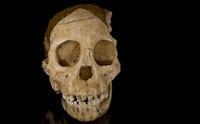Great pitchers make it look so easy, and “practice makes perfect,” but it helps that the brain power necessary for control, neurological connections, and muscular arrangements for the human arm are exceedingly better than any system that exists on the planet. Is throwing a ball really that complex? More… …read more Read more here: icr.org
Scientists purposefully made mice sick to test how the creatures’ intestines—and the microbes they harbor—would react. They discovered details behind a remarkable relationship that, when working well, keeps both parties healthy. More… …read more Read more here: icr.org
Human faces evolved to vary as much as Mr. and Mrs. Potato Head, evolutionists say. …read more Read more here: AIG Daily
Because our universe is in such a stable state, it speaks of a Creator and causes major headaches for atheists. …read more Read more here: creation.com
By Ken Ham Black holes form the background in many science fiction stories. But black holes are not fictional. A black hole, as you probably know, is so massive and dense that even light cannot escape from its enormous gravity, so it is invisible. Even though we cannot “see” black holes the way we see a star or the moon, there is overwhelming observational evidence that they do exist. Astronomers are able to see the effects of their enormous gravity on other things in space. So if that is the case, why have two secular scientists now claimed that black [More]
Tiny technology—an environmentally matched biological cloaking device—hides shrimp in plain sight. …read more Read more here: AIG Daily
Few animal traits are trotted out as illustrations of evolution as often as the whale’s supposed vestigial hip bones. Recent research has uncovered new details about the critical function of these whale hips—details that undermine this key evolutionary argument and confirm divine design. More… …read more Read more here: icr.org
Katydids solve acoustic impedance matching problem in tiny ears on their legs. This could inspire designs of tiny microphones. …read more Read more here: creation.com
Jurassic mammals made headlines recently, as Chinese paleontologists described six tiny skeletons comprising three new species. The squirrel-like fossils break the long-held idea that most so-called “dinosaur-era” mammals resembled shrews. These newfound mammals look like they lived in trees—not underground like shrews. Do the new fossils help evolutionists clarify their story for the origin of mammals, or do they crank more twists into evolution’s troubled saga? More… …read more Read more here: icr.org
A fossil group of alleged evolutionary human ancestors called australopithecines—all quite ape-like in their features—have traditionally been uncooperative as transitional forms. Now the famous Taung child, a supposed example of early transitional skull features, has been debunked. More… …read more Read more here: icr.org
‘A dog is man’s best friend’? But there are good reasons to beware the dingo! …read more Read more here: creation.com
Deep inside the earth, there’s a lot of water. Is there a connection with Noah’s Flood? …read more Read more here: creation.com
With mice and men, practice makes perfect, but a mouse with a man’s FOXp2 gene achieves perfection faster. …read more Read more here: AIG Daily
The Standard Model of particle physics is on a collision course with the Big Bang model. …read more Read more here: creation.com
Animals were flexing their muscles even “before” the Cambrian Explosion. …read more Read more here: AIG Daily
New fossil finds further verify one of evolution’s biggest problems: the Cambrian explosion. According to evolutionary reckoning, a massive explosion of new life supposedly spawned dozens of brand-new fully formed body plans about 530 million years ago. Details from a newly described Canadian fossil fish intensify this Cambrian conundrum. More… …read more Read more here: icr.org
Secular astrophysicists often talk about “primordial nucleosynthesis” as though it were a proven historical event. In theory, it describes how certain conditions during an early Big Bang universe somehow cobbled together the first elements. But no historical evidence corroborates this primordial nucleosynthesis, an idea beset by a theoretical barrier called the “lithium problem.” Secular scientists recently put this problem to a practical test. More… …read more Read more here: icr.org
From various problems in cosmology a need has developed to postulate the existence of unknown types of energy and matter from the dark side. …read more Read more here: AIG Daily
Researchers say that cliff swallows are ‘evolving’ shorter wings to avoid being killed by fast-moving vehicles. …read more Read more here: creation.com
One-cell creatures called ciliates are expanding the concept of genome complexity at an exponential rate. Now a newly sequenced ciliate genome reveals unimaginable levels of programmed rearrangement combined with an ingenious system of encryption. More… …read more Read more here: icr.org
Surprising evolutionists but not biblical creationists, scientists have discovered an additional layer of information in DNA. …read more Read more here: AIG Daily
How do you go from ‘flat’ oysters to coiled shells? …read more Read more here: creation.com
Social psychologists are tracking IQ scores and noticed a decline in the last decade after a steady rise since the 1950s. Some wonder if the recent downturn reflects genes that have been eroding all along. Are we evolving stupidity? More… …read more Read more here: icr.org
Did caffeine evolve again and again or did our Common Designer provide many plants with the genes to make it? …read more Read more here: AIG Daily
When added to previously determined kinds of extant anurans, caudates, and gymnophionans, a total of 248 amphibian kinds may have been brought on board the Ark. …read more Read more here: AIG Daily
Five seafloor scour troughs show tell-tale signs of having been gouged out by colossal icebergs. But none of today’s icebergs are nearly big enough to scour the seafloor at such a great depth. More… …read more Read more here: icr.org
The colugo glides like no other mammal on earth and proves that our ingenious Creator knows how to surprise us. …read more Read more here: AIG Daily













































